Solvay Conference
The International Solvay Institutes for Physics and Chemistry, located in Brussels, were founded by the Belgian industrialist Ernest Solvay in 1912, following the historic invitation-only 1911 Conseil Solvay, considered a turning point in the world of physics. The Institutes coordinate conferences, workshops, seminars, and colloquia.[1]
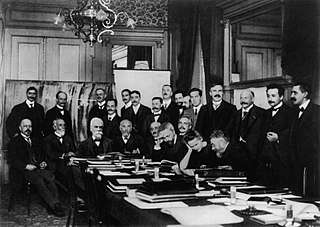
Following the initial success of 1911, the Solvay Conferences (Conseils Solvay) have been devoted to outstanding preeminent open problems in both physics and chemistry. The usual schedule is every three years, but there have been larger gaps.
Notable Solvay Conferences
First Conference
Hendrik Lorentz was chairman of the first Solvay Conference held in Brussels from 30 October to 3 November 1911.[2] The subject was Radiation and the Quanta. This conference looked at the problems of having two approaches, namely classical physics and quantum theory. Albert Einstein was the second youngest physicist present (the youngest one was Lindemann). Other members of the Solvay Congress included such luminaries as Marie Curie and Henri Poincaré (see image for attendee list).
Third Conference
The Third Solvay Conference was held in April 1921, soon after World War I. Most German scientists were barred from attending. In protest at this action, Albert Einstein, himself a citizen and a vocal supporter of the infant Weimar Republic, declined his invitation to attend the conference where most of his countrymen were barred. However, the real reason of Einstein's absence is because he accepted the invitation by Dr. Chaim Weizmann for a trip to the United States.[3]
Fifth Conference
Perhaps the most famous conference was the Fifth Solvay Conference on Electrons and Photons held from 24 to 29 October 1927, where the world's most notable physicists met to discuss the newly formulated quantum theory. The leading figures were Albert Einstein and Niels Bohr. 17 of the 29 attendees were or became Nobel Prize winners, including Marie Curie, who alone among them, had won Nobel Prizes in two separate scientific disciplines.[4]

P. Debye, M. Knudsen, W.L. Bragg, H. A. Kramers, P. A. M. Dirac, A. H. Compton, L. de Broglie, M. Born, N. Bohr;
I. Langmuir, M. Planck, M. Curie, H.A . Lorentz, A. Einstein, P. Langevin, Ch.-E. Guye, C. T. R. Wilson, O. W. Richardson
Solvay Conferences on Physics
| No | Year | Title | Translation | Chair |
|---|---|---|---|---|
| 1 | 1911 | La théorie du rayonnement et les quanta | The theory of radiation and quanta | Hendrik Lorentz (Leiden) |
| 2 | 1913 | La structure de la matière | The structure of matter | |
| 3 | 1921 | Atomes et électrons | Atoms and electrons | |
| 4 | 1924 | Conductibilité électrique des métaux et problèmes connexes | Electric conductivity of metals and related problems | |
| 5 | 1927 | Electrons et photons | Electrons and photons | |
| 6 | 1930 | Le magnétisme | Magnetism | Paul Langevin (Paris) |
| 7 | 1933 | Structure et propriétés des noyaux atomiques | Structure & properties of the atomic nucleus | |
| 8 | 1948 | Les particules élémentaires | Elementary particles | Lawrence Bragg (Cambridge) |
| 9 | 1951 | L'état solide | The solid state | |
| 10 | 1954 | Les électrons dans les métaux | Electrons in metals | |
| 11 | 1958 | La structure et l'évolution de l'univers | The structure and evolution of the universe | |
| 12 | 1961 | La théorie quantique des champs | Quantum field theory | |
| 13 | 1964 | The Structure and Evolution of Galaxies | J. Robert Oppenheimer (Princeton) | |
| 14 | 1967 | Fundamental Problems in Elementary Particle Physics | Christian Møller (Copenhagen) | |
| 15 | 1970 | Symmetry Properties of Nuclei | Edoardo Amaldi (Rome) | |
| 16 | 1973 | Astrophysics and Gravitation | ||
| 17 | 1978 | Order and Fluctuations in Equilibrium and Nonequilibrium Statistical Mechanics | Léon Van Hove (CERN) | |
| 18 | 1982 | Higher Energy Physics | ||
| 19 | 1987 | Surface Science | F. W. de Wette (Austin) | |
| 20 | 1991 | Quantum Optics | Paul Mandel (Brussels) | |
| 21 | 1998 | Dynamical Systems and Irreversibility | Ioannis Antoniou [5] (Brussels) | |
| 22 | 2001 | The Physics of Communication | ||
| 23 | 2005 | The Quantum Structure of Space and Time | David Gross (Santa Barbara) | |
| 24 | 2008 | Quantum Theory of Condensed Matter | Bertrand Halperin (Harvard) | |
| 25 | 2011 | The theory of the quantum world | David Gross | |
| 26 | 2014 | Astrophysics and Cosmology | Roger Blandford (Stanford) | |
| 27 | 2017 | The physics of living matter: Space, time and information in biology | Boris Shraiman (Santa Barbara) | |
Conferences on Physics gallery
 First Conference, 1911
First Conference, 1911 Second Conference, 1913
Second Conference, 1913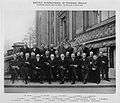 Third Conference, 1921
Third Conference, 1921 Fourth Conference, 1924
Fourth Conference, 1924 Fifth Conference, 1927
Fifth Conference, 1927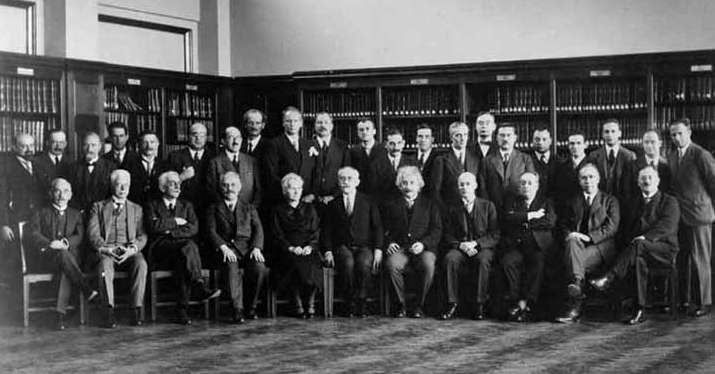 Sixth Conference, 1930
Sixth Conference, 1930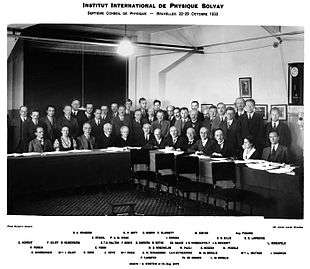 Seventh Conference, 1933
Seventh Conference, 1933 Eighth Conference, 1948
Eighth Conference, 1948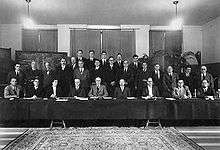 Ninth Conference, 1951
Ninth Conference, 1951 Tenth Conference, 1954
Tenth Conference, 1954
Solvay Conferences on Chemistry
| No | Year | Title | Translation | Chair |
|---|---|---|---|---|
| 1 | 1922 | Cinq Questions d'Actualité | Five topical questions | William Jackson Pope (Cambridge) |
| 2 | 1925 | Structure et Activité Chimique | Structure and Chemical Activity | |
| 3 | 1928 | Questions d'Actualité | Topical Questions | |
| 4 | 1931 | Constitution et Configuration des Molécules Organiques | Constitution and Configuration of Organic Molecules | |
| 5 | 1934 | L'Oxygène, ses réactions chimiques et biologiques | Oxygen, and its chemical and biological reactions. | |
| 6 | 1937 | Les vitamines et les Hormones | Vitamins and Hormones | Frédéric Swarts (Ghent) |
| 7 | 1947 | Les Isotopes | Isotopes | Paul Karrer (Zurich) |
| 8 | 1950 | Le Mécanisme de l'Oxydation | The mechanism of oxidation | |
| 9 | 1953 | Les Protéines | Proteins | |
| 10 | 1956 | Quelques Problèmes de Chimie Minérale | Some Problems of Inorganic Chemistry | |
| 11 | 1959 | Les Nucléoprotéines | Nucleoproteins | Alfred Ubbelohde (London) |
| 12 | 1962 | Transfert d'Energie dans les Gaz | Energy transfer in gases | |
| 13 | 1965 | Reactivity of the Photoexcited Organic Molecule | ||
| 14 | 1969 | Phase Transitions | ||
| 15 | 1970 | Electrostatic Interactions and Structure of Water | ||
| 16 | 1976 | Molecular Movements and Chemical Reactivity as conditioned by Membranes, Enzymes and other Molecules | ||
| 17 | 1980 | Aspects of Chemical Evolution | ||
| 18 | 1983 | Design and Synthesis of Organic Molecules Based on Molecular Recognition | Ephraim Katchalski (Rehovot) & Vladimir Prelog (Zurich) | |
| 19 | 1987 | Surface Science | F. W. de Wette (Austin) | |
| 20 | 1995 | Chemical Reactions and their Control on the Femtosecond Time Scale | Pierre Gaspard (Brussels) | |
| 21 | 2007 | From Noncovalent Assemblies to Molecular Machines | Jean-Pierre Sauvage (Strasbourg) | |
| 22 | 2010 | Quantum Effects in Chemistry and Biology | Graham Fleming (Berkeley) | |
| 23 | 2013 | New Chemistry and New Opportunities from the Expanding Protein Universe | Kurt Wüthrich (ETH Zurich) | |
| 24 | 2016 | Catalysis in Chemistry and Biology | Kurt Wüthrich (ETH Zurich) & Robert Grubbs (Caltech, USA) | |
| 25 | 2019 | Computational Modeling: From Chemistry to Materials to Biology | Kurt Wüthrich (ETH Zurich) & Bert Weckhuysen (Utrecht U., The Netherlands) | |
Conferences on Chemistry gallery
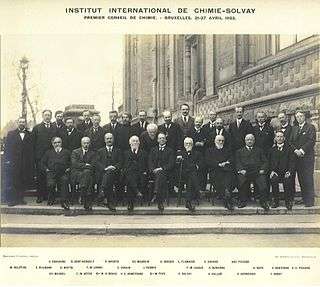 First Conference, 1922
First Conference, 1922
References
- Welcome to the Solvay Institutes
- Paul Langevin and Maurice de Broglie, eds., La théorie du rayonnement et les quanta. Rapports et discussions de la réunion tenue à Bruxelles, du 30 octobre au 3 novembre 1911, sous les auspices de M. E. Solvay. Paris: Gauthier-Villars, 1912. See also: The Collected Papers of Albert Einstein, Vol. 3: Writings 1909–1911, Doc. 26, p. 402 (English translation supplement).
- Isaacson, Walter (2007). Einstein: His life and universe. New York: Simon & Schuster.
- Lorentz & the Solvay conferences, Instituut-Lorentz, Leiden University
- http://users.auth.gr/~iantonio/IAEnglish.html
Further reading
- Straumann, N. (2011). "On the first Solvay Congress in 1911". European Physical Journal H. arXiv:1109.3785. Bibcode:2011EPJH...36..379S. doi:10.1140/epjh/e2011-20043-9.
- (in French) Franklin Lambert & Frits Berends: Vous avez dit : sabbat de sorcières ? La singulière histoire des premiers Conseils Solvay, EDP Sciences - Collection : Sciences et Histoire - octobre 2019
- (in English) Frits Berends, Franklin Lambert: paperity.org "Einstein's witches' sabbath: the first Solvay council", Europhysics News, 42/5 pp 15–17, 2011
External links
| Wikimedia Commons has media related to Solvay Conference. |
- International Solvay Institutes (official website)
- The Solvay Science Project(Exhibition and database)
- Previous Solvay Conferences on Physics
- Previous Solvay Conferences on Chemistry
- Proceedings 1911
- Proceedings 1913
- Proceedings 1933
- Overview of the transcript of the famous Fifth Conference — American Institute of Physics
- Bacciagaluppi G., Valentini A. (2009.) Quantum Theory at the Crossroads: Reconsidering the 1927 Solvay Conference, Cambridge University Press, Cambridge, UK